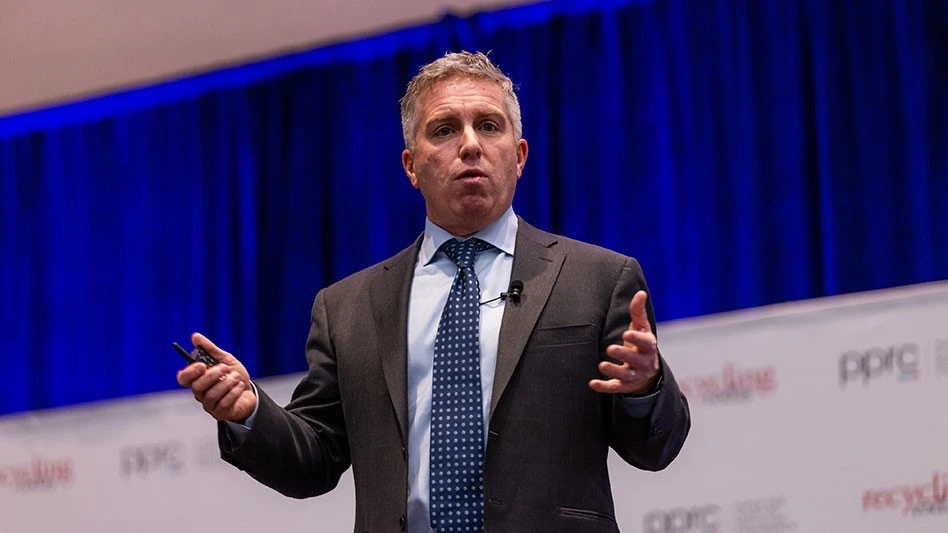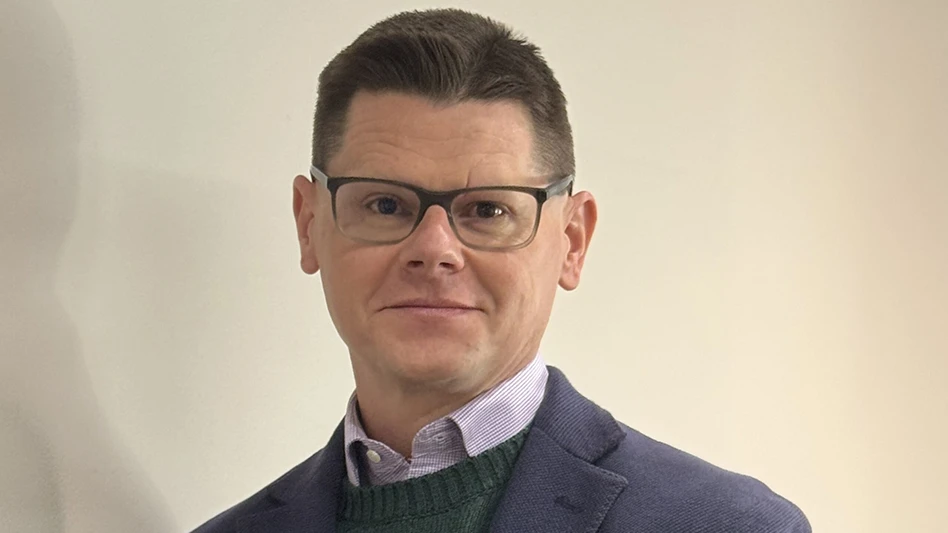
Photo by Mark Campbell Productions
In his Oct. 19 keynote presentation at the Paper & Plastics Recycling Conference, Tom Joyce, managing director and capital market strategist at MUFG Bank Ltd., apologized for delivering what he described as “not the most optimistic outlook,” adding, “It’s hard to be constructive if the low point is in the first half of 2023.” He warned attendees that a “difficult six months” still lay ahead from a macroeconomic standpoint.
“We will get through this period,” Joyce said, adding that while it will not be on par with the 2008 economic collapse, it will be “a difficult time in the market and the economy.”
Joyce stressed that the situation is not unique to the United States, pointing to a “massive synchronized inflation problem” globally. “Everywhere I go, inflation is a problem, and labor shortages are a problem.”
He added all 90 of the world’s central banks are engaging in policy tightening to address inflation. “This has never happened in my 27 years on Wall Street.”
“Nearly every major economy in the world is decelerating at the same time,” Joyce said, adding that Russia and China are exceptions. Such a global deceleration happened in 2016 and during the U.S.-China trade war of 2018. “But it's happening more powerfully right now. And that is a very difficult environment to be in.”
The combination of synchronized policy tightening and synchronized deceleration is leading to a desynchronized sell-off in markets globally, Joyce said, noting that everything but the U.S. dollar and energy commodities have traded negatively this year.
“When the dollar goes on these little strengthening runs, it’s not really good for the global economy,” he said. “And, eventually, it kind of feeds back to the U.S. and it's not entirely positive.”
Joyce said that while the stock market typically has a 20 percent correction every two years, that is not typical in the investment-grade bond market. “In 50 years, that number has been negative only four times—only four times—and we've never had a double-digit negative year. And this year, that market is down 20 percent.”
Much of the economic turmoil has been fueled by global supply-side shocks that started in 2018 with the U.S.-China trade war, the COVID-19 crisis in 2022 and the Russia-Ukraine crisis that began this February. “We had three major shocks to the global economy back to back, and global supply chains all began to change throughout each of these individual crises,” Joyce said.
Regarding the conflict between Russia and Ukraine, while it is fairly contained from a military perspective, he said, it has evolved into a larger geoeconomic war between Russia and the West that has driven energy prices higher and forced Europe to change its energy policy, reducing its natural gas dependency on Russia from 40 percent to 9 percent in just eight months.
“Russia is losing this war on the ground, and that has implications for all of us in this room,” Joyce said. “Russia is too weak to win this war, which has been a surprise, and they are too strong to lose it. Capitulation is not an option. It is highly, highly unlikely. And, so, I think we should expect for this to go a little longer rather than shorter, get a little worse before it gets better.”
Joyce said that within three to six months, the maximum impact of the global monetary tightening will be felt, giving way to a desynchronized global recovery in the second half of 2023 that will see Europe and the U.K. taking longer to realize than the U.S.
“I think the data is pretty obvious that Europe and U.K. are entering recession now, right now as we speak in early Q4, but will roll into Q1 and maybe extend a bit longer into Q2 and beyond or just be very weak in the beyond,” he said. “And the United States and the global economy sort of head into that zip code sometime over the next six to nine months.
“The next recession is probably going to be a little long and deep in Europe in the U.K. Nothing like ’08-’09, but uncomfortably long with a shallow recovery,” Joyce continued. “But the one in the U.S. and probably the one globally, we think it will be short and moderate in size—less than a 1 percent contraction, maybe a half a point contraction, in the U.S. economy.”
He said the U.S. is more resilient than most countries in the world in terms of the factors affecting the economy currently given that the country is energy- and food-independent and exports are only 11 percent of U.S. gross domestic product (GDP), whereas in Germany, the world’s fourth-largest economy, international trade is 40 percent of its GDP, leaving it exposed to Russia and China.
“It will get better in the second half of 2023 in our base-case view, but we have more difficult months ahead. The geopolitical situation is likely to get a fair bit worse, the economy, we think, is going to get a little bit worse and then recover.”
The Recycling Today Media Group hosted the Paper & Plastics Recycling Conference Oct. 19-20 in Chicago.
Latest from Recycling Today
- China to introduce steel export quotas
- Thyssenkrupp idles capacity in Europe
- Phoenix Technologies closes Ohio rPET facility
- EPA selects 2 governments in Pennsylvania to receive recycling, waste grants
- NWRA Florida Chapter announces 2025 Legislative Champion Awards
- Goldman Sachs Research: Copper prices to decline in 2026
- Tomra opens London RVM showroom
- Ball Corp. makes European investment





